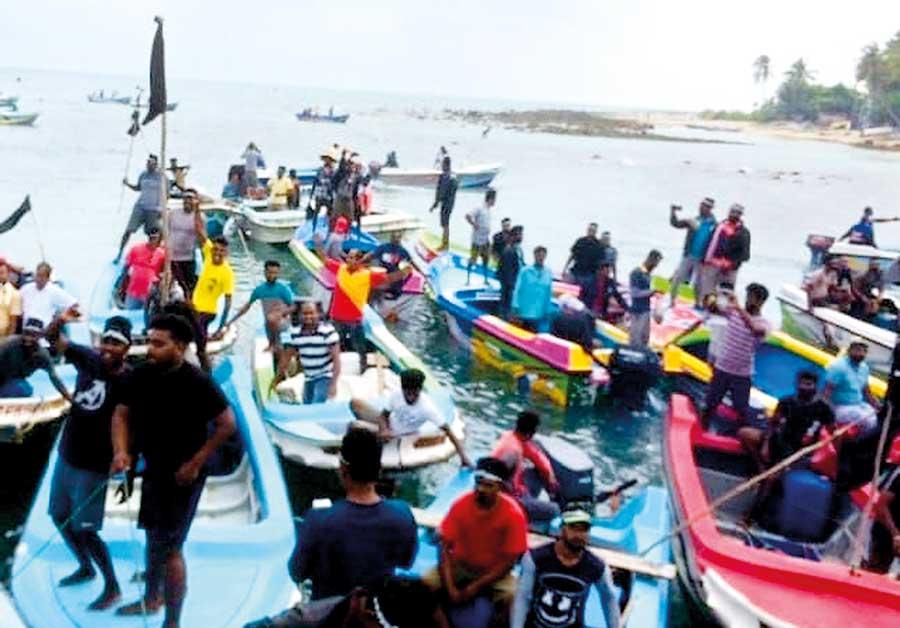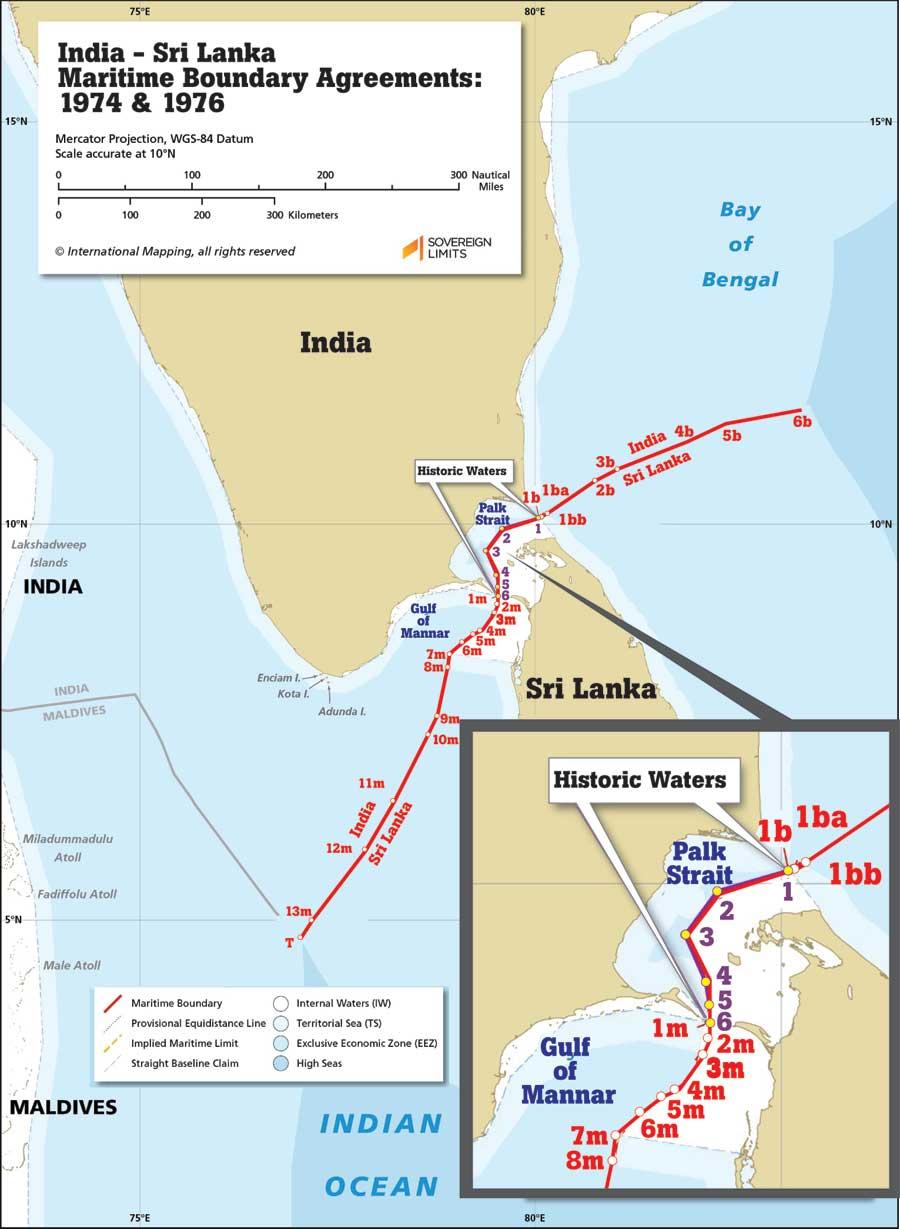22 Oct 2021 - {{hitsCtrl.values.hits}}
The Indo-Sri Lanka battle for fish

Protest held by Northern fishermen from Mullaitivu to point pedro earlier this week
Pic by Romesh Madusanka
For over a century Sri Lanka and India has been struggling to find a permanent solution to its maritime dispute. What began as claiming ownership over Katchatheevu, an uninhabited island located in the Palk Strait has extended to a bigger issue concerning the rights of fishermen and depletion of marine resources in Sri Lanka’s waters. Even though bilateral agreements have clearly mentioned that Indian fishermen do not have the right to fish or engage in bottom trawling in Sri Lanka’s waters, hundreds of Indian fishing boats continue to invade Sri Lanka’s marine territory on any given day. Even though successive governments have held discussions with Indian counterparts, the matter remains unsolved to date even after a law was passed in 2017 to ban bottom trawling in Sri Lankan waters. On one hand, Sri Lanka cannot lose her good old Big Brother at any cost, and on the other, Sri Lanka has become an important geopolitical location that many countries are desperate to partner with. Where exactly the continuing ‘I scratch your back, you scratch mine’ agenda would take this matter to remains a question.
dispute. What began as claiming ownership over Katchatheevu, an uninhabited island located in the Palk Strait has extended to a bigger issue concerning the rights of fishermen and depletion of marine resources in Sri Lanka’s waters. Even though bilateral agreements have clearly mentioned that Indian fishermen do not have the right to fish or engage in bottom trawling in Sri Lanka’s waters, hundreds of Indian fishing boats continue to invade Sri Lanka’s marine territory on any given day. Even though successive governments have held discussions with Indian counterparts, the matter remains unsolved to date even after a law was passed in 2017 to ban bottom trawling in Sri Lankan waters. On one hand, Sri Lanka cannot lose her good old Big Brother at any cost, and on the other, Sri Lanka has become an important geopolitical location that many countries are desperate to partner with. Where exactly the continuing ‘I scratch your back, you scratch mine’ agenda would take this matter to remains a question.

Move to instigate violence among fisherfolk in TN and SL’s North and East: Shanakiyan Rasamanickam
On October 17, Sri Lankan fishermen in the North staged a protest against illegal bottom trawling taking place in the Northern and Eastern coasts despite having a law. They set out in boats from the coast of Mullaitivu all the way up to Point Pedro. The protest was led by Tamil National Alliance MPs including M. A. Sumanthiran, Shanakiyan Rasamanickam, S. Sritharan and former MP Shanthi Sriskantharajah who also set out on boats staging their opposition against bottom trawling. The MPs urged Fisheries Minister Douglas Devananda to initiate appropriate legal action against fishermen engaging in bottom trawling.
“In 2017 the law was passed to ban bottom trawling but there’s a move to cause a rift between people in Tamil Nadu and Sri Lankan Tamils in the North and East,” opined Tamil National Alliance MP Shanakiyan Rasamanickam. “We oppose anything that’s illegal and what we request the government is to enforce the law rather than instigating violence. Fishermen have complained that they can’t carry out their livelihoods but they cannot openly communicate their issues.”
When asked if this is an ongoing dispute as result of claiming Katchatheevu, MP Sanakiyan said that all such issues are brought to light to distract public from the main problem at hand. “There are around 20-30 people engaged in bottom trawling and this is ruining our marine resources. It has affected the livelihoods of fishermen mainly in the Northern Province.”
Unsettled geopolitical matters
“We oppose anything that’s illegal and what we request the government is to enforce the law rather than instigating violence. Fishermen have complained that they can’t carry out their livelihoods but they cannot openly communicate their issues. - Shanakiyan Rasamanickam”
However, Fisheries Minister Douglas Devananda claims that the matter has been brought to the attention of the Indian Prime Minister Narendra Modi, India’s External Affairs Minister S. Jaishankar, Indian High Commissioner of Sri Lanka and the Tamil Nadu government. The matter has been discussed during BJP Leader Subramanian Swamy’s recent visit to Sri Lanka. Swamy has assured that he would raise the issue in the Indian Parliament. In the meantime, Devananda is of the view that any Indian fishermen who are caught fishing on Sri Lankan waters should be arrested. He blamed the TNA for creating a drama and pointed out that holding him responsible for not finding a solution to the matter is baseless. Following the protest Tamil Nadu government leaders have reportedly informed Indian fishermen to refrain from entering Sri Lankan waters and engaging in bottom trawling. A committee comprising fishermen and marine associations of Sri Lanka and India too will be setup to engage in discussions to find a solution to the matter. But whether discussions, that have proven to have been ineffective over the years would provide a solution at least now remains a question.
Fisheries unions prepping to go to courts
“Fishermen alone cannot take this decision and a state level intervention was required. But there was no progress. Then again in 2012/2013 fishermen from both countries discussed the matter again. That too wasn’t successful and they said they needed three more years to find a solution to the matter - Anthony Jesudasan (NAFSO)”
The law was proposed as a Private Members Bill by TNA MP M. A. Sumanthiran. The Bill amended Section 28 of the Fisheries and Aquatic Resources Act No. 2 of 1996. An amendment was also made to the Fisheries (Regulation of Foreign Fishing Boats) Act No. 59 of 1979. But even though Sri Lanka became the first country in Asia to ban bottom trawling, these laws have not yet been enforced.
“These laws can be used to put an end to these activities and apart from that Indian Fishermen are violating an international maritime border,” said Anthony Jesudasan, Project Coordinator of the National Fisheries Solidarity Organisation (NAFSO). “Even though it was brought in during the Yahapalana regime, the Indian fishermen continue to invade Sri Lankan waters. Back in 2004 during the height of the war there would be around 1500-2000 fishing boats on any given day. They used to come on Monday, Wednesday and Saturday. In August 2010 a delegation of 22 officials visited eight districts in Tamil Nadu and discussed matters with them. During this meeting they asked us to give them one year to do fishing in our waters and promised that they wouldn’t use trawling or other haphazard methods to catch fish.”
“But fishermen alone cannot take this decision and a state level intervention was required. But there was no progress. Then again in 2012/2013 fishermen from both countries discussed the matter again. That too wasn’t successful and they said they needed three more years to find a solution to the matter. In 2016 the then Fisheries Minister Mahinda Amaraweera went to New Delhi to discuss the matter and here the Indian fishermen have said that they need to do fishing activities on 80 days per year and have requested for a further three years to solve the issue. Even though the Fisheries and Aquatic Resources (Amendment) Act No. 11 of 2017 was passed it has not been enacted to date.”
Jesudasan further said that they would be filing a case at the Supreme Court along with 1000 other fishermen, social activists etc., appearing as complainants to question the government on why the law is not been enacted. “A few days ago, the Indian fishermen have cut off the nets of around 15 local fishermen. One of those nets cost between Rs. 180,000-200,000. So far none of the local fishermen who have been affected by this issue has received compensation either. This isn’t a problem in the North but a national crisis today.”
Environmental impacts of bottom trawling
“It takes away color fish, sea cucumber and other marine resources. Bottom trawling is prohibited on a global scale but even when a few Indian fishermen were apprehended, they had to be released. Now there are more boats doing bottom trawling. - Dr. Ranil Nanayakkara (BEAR)”
The environmental impacts of bottom trawling are manifold. It not only scoops off mollusks, shrimps and sea grass but only around 20-30% of the yield is utilized. “The rest is by-catch and is discarded in most instances, “opined Dr. Ranil Nanayakkara, co-Founder and principal scientist at Biodiversity Education and Research (BEAR). “It takes away color fish, sea cucumber and other marine resources. Bottom trawling is prohibited on a global scale but even when a few Indian fishermen were apprehended, they had to be released. Now there are more boats doing bottom trawling.”
Even though there are alternative, sustainable fishing methods what the Indian fishermen require is still unclear. As per his observations hundreds of boats could be found near the perimeter of the India-Sri Lanka maritime border. “By 12 midnight they reach our waters, do fishing and leave by morning.”
When asked if bottom trawling has an impact on a particular marine species, Dr. Nanayakkara said that there’s nothing left in most areas where bottom trawling has taken place. “Only sand is left. Bottom trawling has destroyed the sea grass bed and has also posed threats to dolphins, sharks and other aquatic mammals. The sawfish population for example has drastically depleted over the years. 15-20 years ago, you could see one or two sawfish from fishing nets but you rarely see them today.”
These activities mainly happen along Gulf of Mannar all the way up to the Palk Bay. As such Dr. Nanayakkara suggests that a political intervention is needed to solve the issue as these maritime areas are important for both countries.
Declaring Environmentally Sensitive Areas
“It is important to have a good strategic management. If you look at the protected areas map such as Kalpitiya, Mannar there are important mangrove patches. If you take an area such as Silawathurai there are seagrass beds and unprotected mangrove patches in each of these coastal ecosystems - Dr. Sevvandi Jayakody”
Following the protest, the Environment Ministry announced that the sea between Mannar to Rameshwaram in India should immediately be designated as a highly sensitive marine ecological zone. Several Environmentally Sensitive Areas (ESAs) too have been identified in the ESA Identification Report presented to the Cabinet by Dr. Sevvandi Jayakody. “The stretch from Gulf of Mannar to Palk Bay is a highly sensitive area because of its ecological importance,” opined Dr. Jayakody who has conducted research on coastal ecosystem management and policy and impacts of human disturbances in ecosystem processes and functions.
“We need to look at improving livelihoods of people in coastal areas and by declaring ESAs the community has a responsibility to manage these areas while engaging in their livelihoods. The near coastal areas of both countries have good protection but when you talk about environmental sensitivity we need to go beyond the continental shelf. The other side of the Gulf of Mannar which is Rameshwaram has already been declared as a Man and Biosphere Reserve,” she added.
Dr. Jayakody further said that many temporary sand islands form along the coastal stretch from Gulf of Mannar to Palk Bay which are important breeding grounds for migratory birds. “Therefore, it is important to have a good strategic management. If you look at the protected areas map such as Kalpitiya, Mannar there are important mangrove patches. If you take an area such as Silawathurai there are seagrass beds and unprotected mangrove patches in each of these coastal ecosystems. Therefore, by declaring ESAs we can educate the community and empower them to protect the ecosystems around them.”
Economic models to be developed
“When there’s no proper income people resort to destroying the environment. These ESAs have been identified for co-management. We want people to make a living while protecting the environment and we will develop economic models depending on ESAs. - Dr. Anil Jasinghe”
When asked if this decision was taken as a solution to the Indian fishermen issue, Environment Ministry Secretary Dr. Anil Jasinghe said that it is a complex matter that needs further discussion. “ESAs are being declared outside protected areas. We do know that organized crimes take place within protected areas. But we have ESAs are at risk due to factors such as population explosion and poverty. When there’s no proper income people resort to destroying the environment. These ESAs have been identified for co-management. We want people to make a living while protecting the environment and we will develop economic models depending on ESAs.”
Already a National Steering Committee on ESAs has been established and an ESA policy is in place. “We will submit this to the Cabinet for approval. We have already identified 200 ESAs and the inaugural meeting was held. The public too can propose certain ESAs if they come across an environmentally sensitive area.”
Navy on standby
“89 Indian fishermen were arrested while fishing on Sri Lankan waters. “Out of them 54 were released in March - SLN spokesman Capt. Indika de Silva.”
In 2021, some 89 Indian fishermen were arrested while fishing on Sri Lankan waters. “Out of them 54 were released in March,” said Sri Lanka Navy spokesman Captain Indika de Silva. “We couldn’t do much patrolling due to the COVID-19 pandemic but we will take all measures to curb these activities.”

26 Nov 2024 1 hours ago
26 Nov 2024 1 hours ago
26 Nov 2024 2 hours ago
26 Nov 2024 2 hours ago
26 Nov 2024 2 hours ago